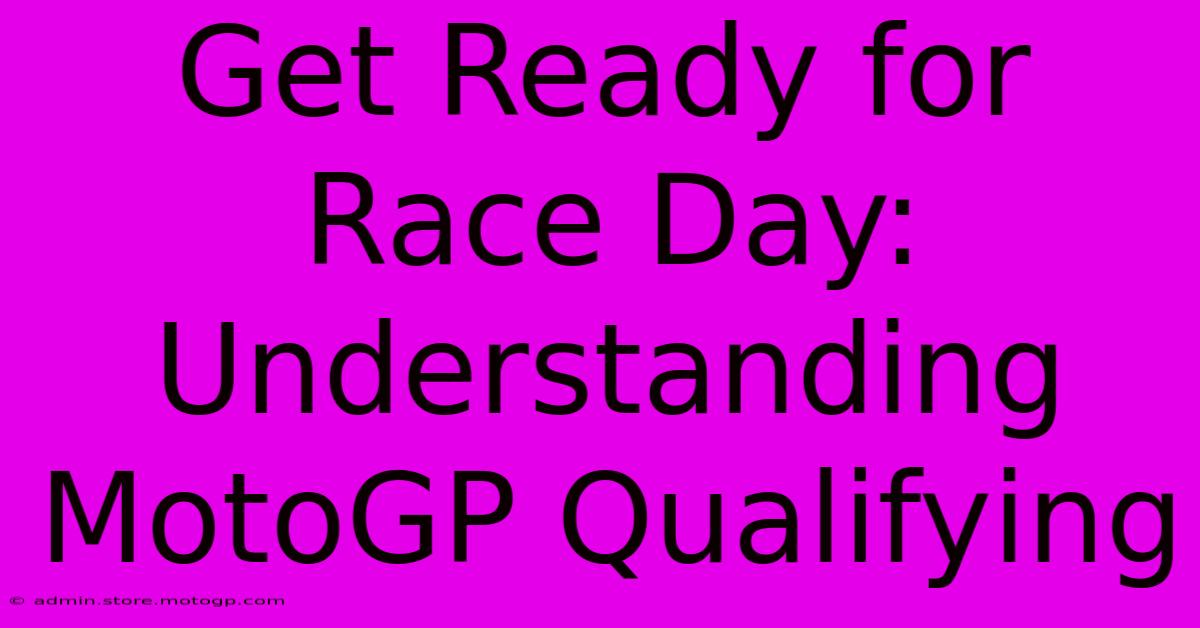Get Ready For Race Day: Understanding MotoGP Qualifying

Table of Contents
Get Ready for Race Day: Understanding MotoGP Qualifying
MotoGP, the pinnacle of motorcycle racing, isn't just about the race itself. A significant portion of the weekend's drama and excitement unfolds during qualifying, determining the crucial grid positions for Sunday's showdown. Understanding the intricacies of MotoGP qualifying is key to fully appreciating the sport's intensity and strategy. This guide breaks down the process, explaining how riders fight for pole position and the implications for the race.
The Qualifying Format: A Breakdown
MotoGP qualifying is a multi-stage process designed to separate the wheat from the chaff, rewarding speed and precision. The current format typically involves:
Q1 (Qualifying 1):
- Participants: The slowest ten riders from the combined free practice sessions (FP1, FP2, and FP3) participate in Q1. This means the riders who didn't set a fast enough lap time in the practice sessions have to battle it out here.
- Duration: A set time limit, usually around 15 minutes.
- Objective: The top two fastest riders from Q1 automatically progress to Q2. The remaining riders start the race from positions 13-20 on the grid (24 in some races). This is a high-pressure environment, where riders must push hard to advance.
Q2 (Qualifying 2):
- Participants: The top ten riders from the combined free practice sessions (FP1, FP2, and FP3) automatically qualify for Q2. They are joined by the two fastest riders who progressed from Q1.
- Duration: A set time limit, usually around 15 minutes.
- Objective: The grid positions for the top 12 positions on the grid are determined in this session. The rider with the fastest lap time in Q2 secures coveted pole position, starting the race from the most advantageous spot on the grid.
The Importance of Qualifying
The impact of qualifying on the race outcome cannot be overstated. Starting at the front of the grid offers several significant advantages:
- Clean Air: The leading riders benefit from cleaner air, experiencing less wind resistance, allowing them to maintain higher speeds and conserve tires.
- Early Track Positioning: Pole position grants the rider an ideal racing line and allows them to dictate the pace in the early laps. This is crucial for establishing a strong lead.
- Strategic Advantage: A good grid position allows riders to control the race, choosing their lines and avoiding potential battles and incidents further down the field.
Consequently, a poor qualifying performance can dramatically hinder a rider's chances, even if they possess the fastest race pace. This is why qualifying is such a vital part of the MotoGP weekend.
Factors Influencing Qualifying Performance
Several factors come into play during qualifying:
- Tire Choice: Selecting the right tires – soft, medium, or hard compound – is critical. A rider needs tires that offer optimal grip and performance for a single, flying lap.
- Track Conditions: Weather, temperature, and even the amount of rubber laid down on the track significantly impact grip and lap times. Adaptability is key.
- Bike Setup: Fine-tuning the bike's suspension, electronics, and aerodynamic settings for a single fast lap is essential. The slightest adjustments can make a huge difference.
- Rider Skill & Fitness: Ultimately, the rider's skill in navigating the track, managing their tires, and executing a perfect lap are paramount. Physical fitness also plays a crucial role in the demanding pressure of qualifying.
Strategies and Tactics in Qualifying
Qualifying isn't just about raw speed; it's about strategic decision-making. Riders often employ various tactics:
- Slipstreaming: Using the slipstream of another rider to reduce air resistance and gain a speed advantage, particularly on long straights. This is a common strategy but requires precise timing and execution.
- Tire Management: Conserving tire life for a final, qualifying lap is often a key part of the strategy.
- Track Knowledge: A deep understanding of the circuit, knowing where to push the limits and where to ease off, is vital for setting fast lap times.
In conclusion, understanding MotoGP qualifying is crucial for any serious fan. It's a captivating display of skill, strategy, and intense competition, setting the stage for the thrilling race to come. By understanding the intricacies of Q1 and Q2, you can appreciate the importance of every lap, every overtaking maneuver, and the battle for pole position. So, next time you watch MotoGP, pay close attention to qualifying – it’s a vital ingredient in the recipe for a memorable race weekend.

Thank you for visiting our website wich cover about Get Ready For Race Day: Understanding MotoGP Qualifying. We hope the information provided has been useful to you. Feel free to contact us if you have any questions or need further assistance. See you next time and dont miss to bookmark.
Featured Posts
-
Witness The Drama Sprint Race Austin
Feb 18, 2025
-
Moto 2 Specs The Winning Edge
Feb 18, 2025
-
Cota Merch Your Go To For Game Day
Feb 18, 2025
-
Motorbike Racing A Test Of Skill And Endurance
Feb 18, 2025
-
Moto Gp Bikes How Much Power Do They Pack
Feb 18, 2025
